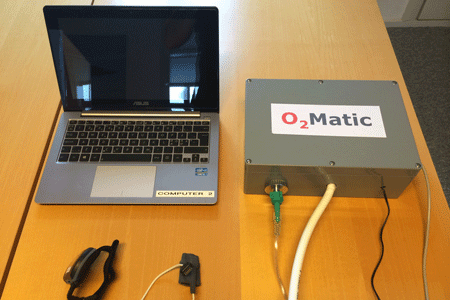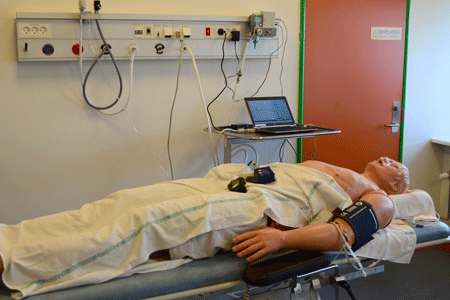A public-private partnership project has laid the foundations for significantly improved treatment of COPD patients.
Shortness of breath, coughing, phlegm in the lungs and fatigue are everyday realities for the 400,000 or so Danish patients who, according to The Danish Lung Association, suffer from Chronic Obstructive Pulmonary Disorder, COPD. But new air can now be breathed into diseased lungs by the oxygen robot O2Matic, which has been developed through a partnership between the Danish company Pactor, Hvidovre Hospital and two robot researchers at DTU.
Patients with COPD have narrowed airways, which makes it difficult for them to breathe. This may result in critically low oxygen levels in the patient’s blood. When the condition worsens, or when lung function becomes minimal, it may be necessary to pump extra oxygen into the patient’s lungs. This often requires hospital admission, where a nurse has to increase and decrease the flow of oxygen manually—typically several times per day.

O2Matic
During the partnership project, the idea arose that COPD treatment could be improved and streamlined by automating the process. The result has now been presented in the form of an oxygen supply robot: O2Matic.
The robot functions like a radiator thermostat that measures the temperature in a room and raises or lowers the temperature if the room is too hot or too cold. O2Matic measures the oxygen level in the patient’s blood via a measuring unit that is placed on the patient’s fingertip and performs light metering based on the principle that the colour of blood changes depending on whether it is rich or poor in oxygen. It is this unit that doctors already use to check oxygen levels in blood. The unit uses Bluetooth to send information about the oxygen level in the blood to a computer, which applies an algorithm to determine whether to increase or decrease the flow of oxygen. The computer then sends a signal to an oxygen supply unit that adjusts the oxygen flow to the patient through a nasal tube. The advantage of automating the process is that O2Matic measures the patient’s oxygen level 24/7, automatically regulating the flow of oxygen by increasing or decreasing it whenever necessary.
Automation of human processes
The field of automation contains enormous potential. Much of what is currently done manually is actually ripe for automation. Even with the knowledge we possess today, as robot researcher Nils Axel Andersen from DTU Electrical Engineering—the other developer behind O2Matic, explains.
“The fundamental principle of automation is already in place. So if you need to automate a given form of behaviour, we can apply the same method. Robots can use the automation principles to regulate anything, and the potential is enormous—particularly in the healthcare sector. The crucial aspect is actually getting in touch with doctors who have a challenge they can explain,” he says.

Reverse innovation
But how can hospital staff find out what researchers can get robots to do? And how can researchers and the healthcare sector itself determine what the hospitals need? The parties have to meet somewhere along the line. And they did last summer, when Farzad Saber from the IT development company Pactor launched a project intended to develop a new technology.
Farzad Saber invited Consultant Ejvind Frausing Hansen from the Division of Pulmonary Medicine at Hvidovre Hospital and Ole Ravn and Nils Axel Andersen from DTU Electrical Engineering to take part in an idea workshop. Here, the participants initiated what he terms a ‘reverse innovation process’:
“The usual approach when developing a technology is to start with a need, i.e. the fact that someone is lacking a particular product or process. Most people tend to be very aware if they have a need. But in this case, the idea was to find out whether it was possible to improve some existing processes at hospitals,” relates Farzad Saber.
When you know about robot technology, for example, it can be relatively simple to imagine doing certain things differently. But it’s not certain that doctors can see the same thing, because they are used to working in a certain way, he explains.
“Sometimes you have to bring in a third party as a catalyst,” he says. And this was the role Pactor played.
Article from DYNAMO no. 38, DTU's quarterly magazine .